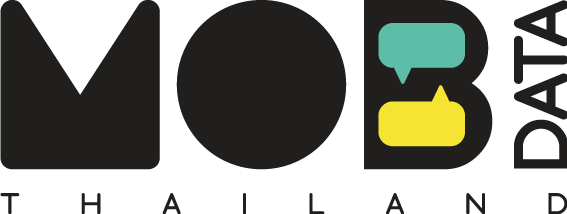Overview of public assembly
The Centre for COVID-19 Situation Administration (CCSA) announced that during the meeting of CCSA on 10 September, there would be the review of the enforcement of the Emergency Decree on Public Administration in the State of Emergency which would expire on 30 September. Then on 11 September 2021, the Regulation no. 33 issued under Section 9 of the Emergency Decree was published in the Government Gazette to retain the existing Covid-19 restrictions including the curfew ban from 15-30 September 2021. In the meantime, Pol Maj Gen Piya Tawichai, Deputy Commissioner of the Metropolitan Police Bureau and its spokesperson said during a press conference on the overall situation of the public assemblies that measures would be ramped up and if possible “within next week, all the disturbance caused by the perpetrators would be brought to an end” Judging from the press conference of the Deputy Commissioner, the authority was tipped to ensure its decisive control of the public assembly, particularly the ones that take place at Din Daeng. And the Metropolitan Police Bureau refers to the independent groups which converge at Din Daeng or the Thalugaz as the “perpetrators”.
Throughout September 2021, at least 141 public assemblies took place countrywide. The leading protest groups included those led by Nattawut Saikua, student groups including the Ramkhahaeng University Network, the United Front of Thammasat and Demonstration, the Democracy Restoration Group (DRG), the Technical College for the People and Democracy, the Resistant Citizen, the We, The People, the Wilar Party, and other alliances such as the Labor Network for People’s Rights and independent groups such as the Thalugaz which has been staging the protest 41 days in a row since 7 August. Their main demand is the removal of General Prayut Chan-ocha as Prime Minister. Meanwhile, the “Stand Stop the Tyranny” by We, The people in Chiang Mai and the Stand Stop Imprisonment by Resistant Citizen at the Supreme Court in Bangkok continued for the 46th and 42nd, respectively to demand the right to bail of political prisoners.
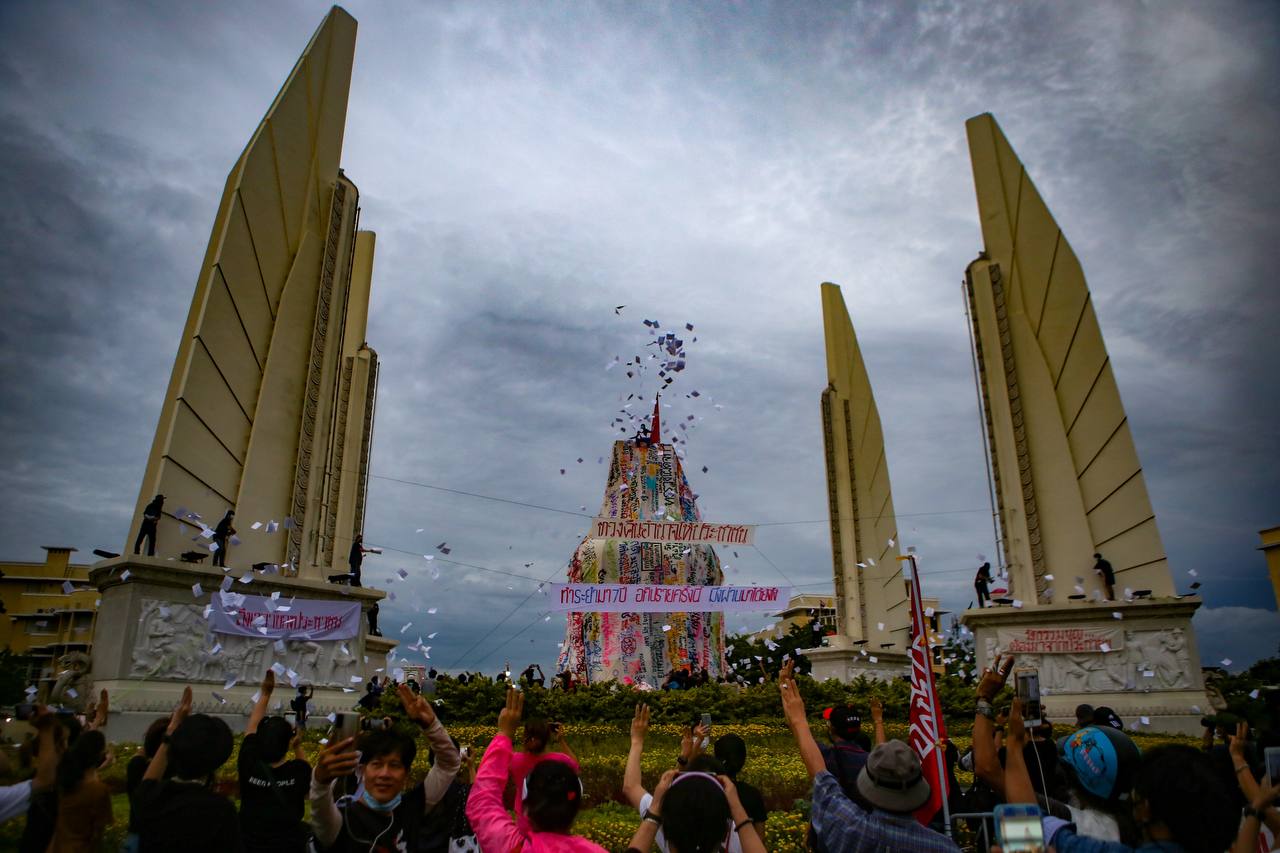
Public assembly organized by Talufah group on 7 September 2021 at the Democracy Monument, Bangkok. Photo by Mob Data Thailand
Given the unrelenting protests at Din Daeng, the authorities have devised measures to rachet up the clampdown on the Thaluagaz including setting checkpoints before and after their assemblies, the adoption o kettling tactic, and the dispersal of the public assembly as well as the application for their arrest warrants after the public assembly and the intimidation before the public assembly. Moreover, the independent protesters at Din Daeng are largely children and youth. According to the Thai Lawyers for Human Rights (TLHR), at least 97 children and youth have been charged in September in 38 cases including at least 24 children under 15 years of age, the youngest of who is 12. One 16-year-old child was denied bail as his parent failed to vouch for him. He was arrested on 23 September 2021 and accused of destroying property including the traffic light control boxes in eight places and eight cases.

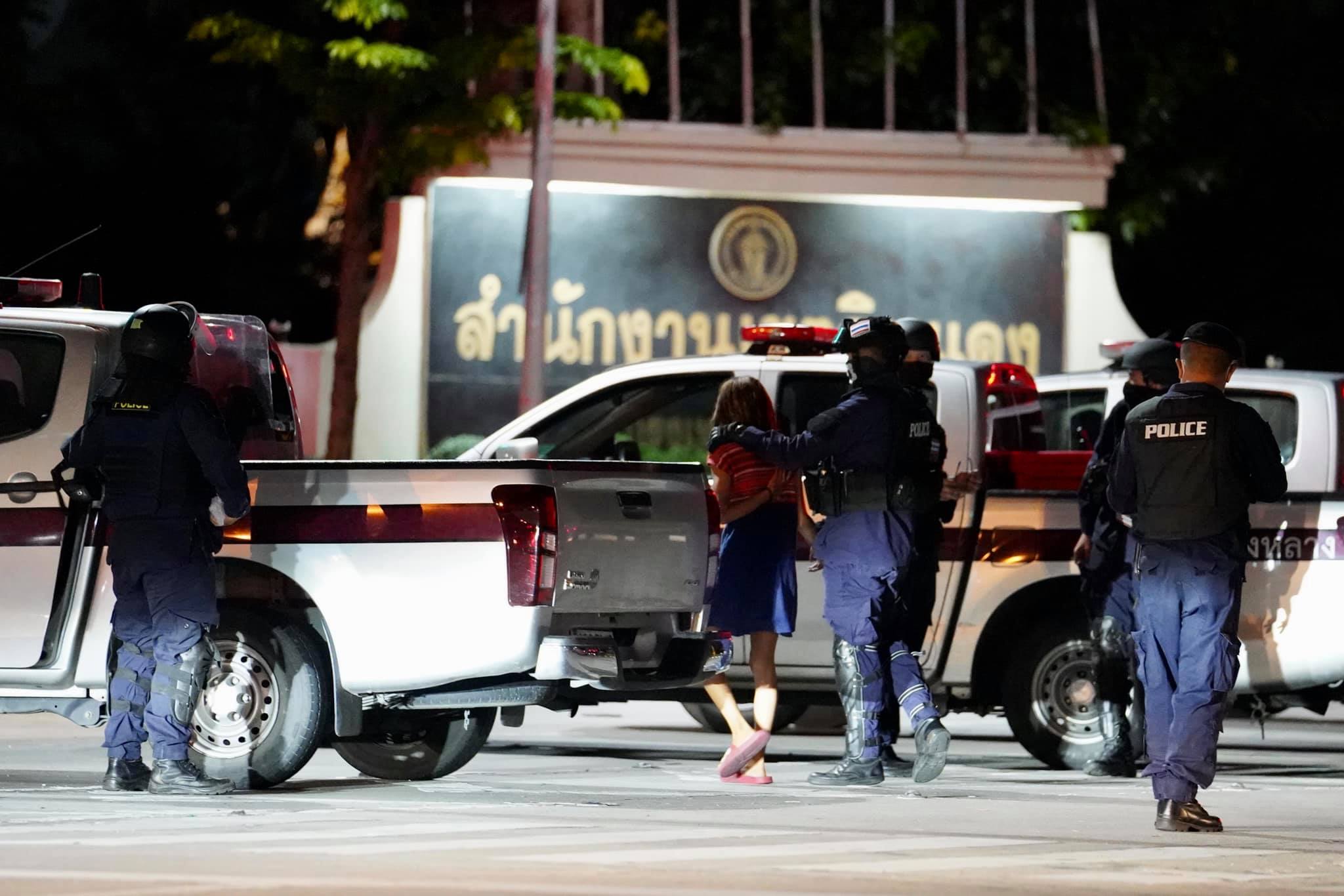
The demonstration and arrest of the Thalugaz group on 23 September 2021. Photo by Kai Maew Cheese
There has been the spike of the number of protesters including children and youth being charged for exercising their freedom of expression and freedom of assembly, the intimidation and arrest before, during and after each assembly. Most of the arrests have been carried out without warrants. It reflects the clampdown aiming to prevent such public assembly from happening again. And when some participants start to use slingshots, tennis ball bombs and firecrackers as well as destroy public property, the authorities would adopt the kettling tactic and refer to the independent protesters as “perpetrators”. Apart from the Thalugaz, other groups that have mobilized politically to oppose the state power have to face such crackdown from the authorities to prevent them from exercising their freedom of expression and to suppress the public assemblies so harshly. Such actions may violate the requirements of necessity and proportionality and will further be explained.
The nature of the use of force by the officials to disperse the protest, the number and example of injured persons and arrestees including children and youth, media and observers
Even though it is clearly stipulated in the General comment No. 37 issued by virtue of Article 21 of the International Covenant on Civil and Political Rights (ICCPR) that dispersal of protest could only be carried out only in exceptional circumstances including when the public assembly is no longer deemed peaceful, or when clear evidence can be established to prove that the situation cannot be addressed by the use of serious violence of the authorities and thereby the authorities are compelled to resort to other more reasonable and proportionate responses. Even though the conditions are met for the authorities to disperse the protest, the public officials are still obliged to act within the bound of the law and in compliance with international human rights standards
Nevertheless, in September, the suppression of the protesters has intensified with the adoption of kettling which does not comply with the General Comment no. 37 which clearly states that it may be used only where it is necessary and proportionate to do so, in order to address actual violence or an imminent threat emanating from that section. Particular care must be taken to contain, as far as possible, only people linked directly to violence and to limit the duration of the containment to the minimum necessary. Where containment is used indiscriminately or punitively, it violates the right of peaceful assembly, and may also violate other rights such as freedom from arbitrary detention and freedom of movement. Moreover, the operations in September have taken much wider toll on the local residents and it demonstrates how the police’s operations are unnecessary including the attempt to isolate unaffiliated media or independent media from the area of the assembly, the arrest of media and the arrest of people not involved with the public assembly as well as the infliction of physical injuries during the arrest.
According to the Thai Lawyers for Human Rights (TLHR), throughout September, the arrests were carried out on 19 days in total and at least 269 have been arrested including at least 18 individuals younger than 15, at least 50 of individuals from 15-18 years. In total, 78 children and youth were arrested. Even though they were not bailed, but it was likely that their bail requests would be denied by the Court which would claim the reason of preventing the recommission of the crime. Bail was also denied for those who had no personal documents or youth whose parents could did not came to vouch for their bail such as the case of Ms. Huat (pseudonym), a homeless Cambodian woman who was arrested from the assembly on 11 September 2021 and had no personal documents. A 16-year-old boy was denied bail as his parents did not show up and he was arrested for allegedly destroying traffic control boxes.

Arrest of demonstrator during the public assembly organized by Thalugaz group on 11 September 2021. Photo by The Standard
Meanwhile, the dispersal of the public assemblies have caused at least 107 injuries including 72 adults and 35 of those younger than 18 years of age. The youngest of them was 13, and there were four of them. At least, five reporters were also injured. There were 80 individuals arrested and charged. Most injuries occurred during the arrests including being stomped on head, or beaten on body, and wounds caused by rubber bullet. At least four sustain serious injuries. At least 32 individuals got injured when they were rammed into by a police vehicle of the crowd control police and the rapid mobile units. Four of the injured persons could not be personally identified.
At least nine individuals have suffered from injuries, albeit not charged, even though they have not participated in the public assemblies. One person has died from crashing his motorbike with the ship containers installed to restrict the demonstration during the night. Moreover, from our observation, we have found the officials have fired rubber bullets and conducted a search in the local private residence at least five times. We have found rubber bullets and tear gas have been fired into the area where a four-month-old child was living.
How the protests were dispersed or stopped
Throughout September, the officials adopted the containment of the area and the dispersal of the public assembly using crowd control equipment not less than 20 times. The officials have adapted kettling tactic a number of times including by setting up checkpoints at the entrance and exit around the Din Daeng Intersection, the containment to conduct mass arrests of the participants, the arrests prior to the start of an event using rapid mobile units and the containment and dispersal of public assembly during the curfew time, particularly in Din Daeng where the independent protesters or Thalugaz converged from the Din Daeng Intersection to Din Daeng Flats 1 on the outbound Vibhavadi Rangsit Rd. at the Royal Thai Army Band Department and area opposite to the Veterans General Hospital, Soi Mitr Maitree 1 intersecting with the inbound Vibhavadi Rangsit Rd. They used water cannon, rubber bullets and tear gas to disperse the crowd when the participants started to gather and hurled objects to the Royal Thai Army Band Department, i.e. on 5 September 2021.
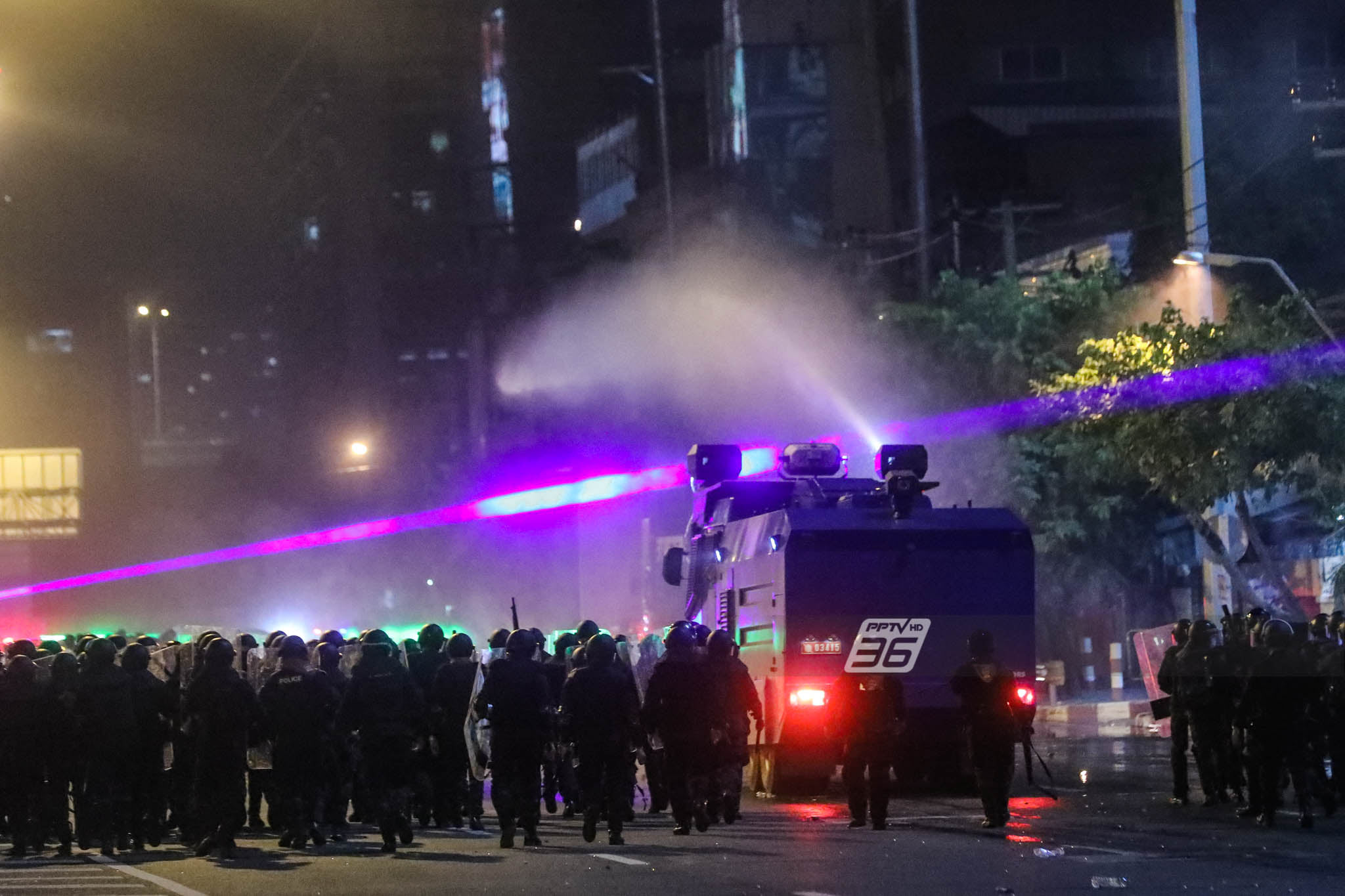
Crowd control police used water cannon to tighten the area during the public assembly organized by Thalugaz group on 5 September 2021. Photo by PPTV HD 36
Nevertheless, the officials used rapid mobile units with the crowd control police boarding the back of pickup trucks and motorcycles to kettle and carry out the arrets. Physical assaults have been committed at least five times against the participants. For example, on 6 September 2021, the rapid mobile police intercepted motorcycles at the exit of Din Daeng Expressway around the Royal Thai Army Band Department. At least 18 participants were arrested and 31 motorcycles were seized. According to one a 17-year-old-child, as the rapid mobile police approached him on motorcycles, he was shot with rubber bullets in his back and was hit on his face causing him to sustain a cut on his lip. According to the livestream feed of Ratsadon News, the crowd control police were arresting and pulling one man from his motorcycle. Even though at least the four police officials have put the man in custody, and the man was pinned down on the ground showing no sign of resistance, one police official his him in his head with a truncheon. After the arrests, the officials announced through speakers that “We could now take charge of the situation promptly and are able to restore traffic space. Apologies to the media for failing to give them prompt warnings and we insist we have acted in compliance with international standards.”
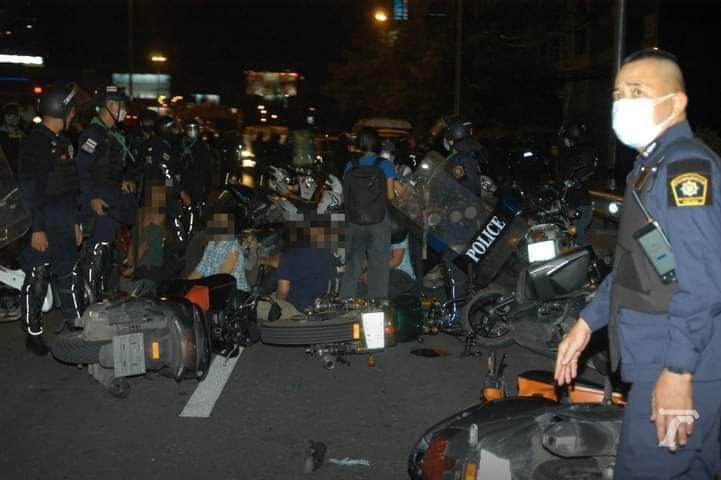
The rapid mobile police arrested the demonstrators during the public assembly on 6 September 2021. Photo by Thairath Online
Just on the following day, on 7 September 2021, the rapid mobile crowd control police with unmarked two pickup trucks with the crowd control police and rubber bullet guns on the back just rammed into the crowd of protesters at the Din Daeng Intersection. At least four were arrested and one person sustained fractured collar bone and another sustained some injury in his lungs. After that, the police have retreated to the Royal Thai Army Band Department. During curfew time, the crowd control police in rapid mobile units have boarded the back of the trucks, armed with shields and guns loaded with rubber bullets, and kettle the protesters at the Din Daeng Intersection again. They asked to examine a press pass of reporter of the Ratsadon News and combed through Din Daeng Flats. Rubber bullets and tear gas were fired into residences in Din Daeng causing damage including broken windows, etc. On 7 September 2021, 15 individuals were arrested with five minors from the age of 14-17 years. At least four of them including one minor insisted that they have not participated in the public assembly, but were arrested on their way home.
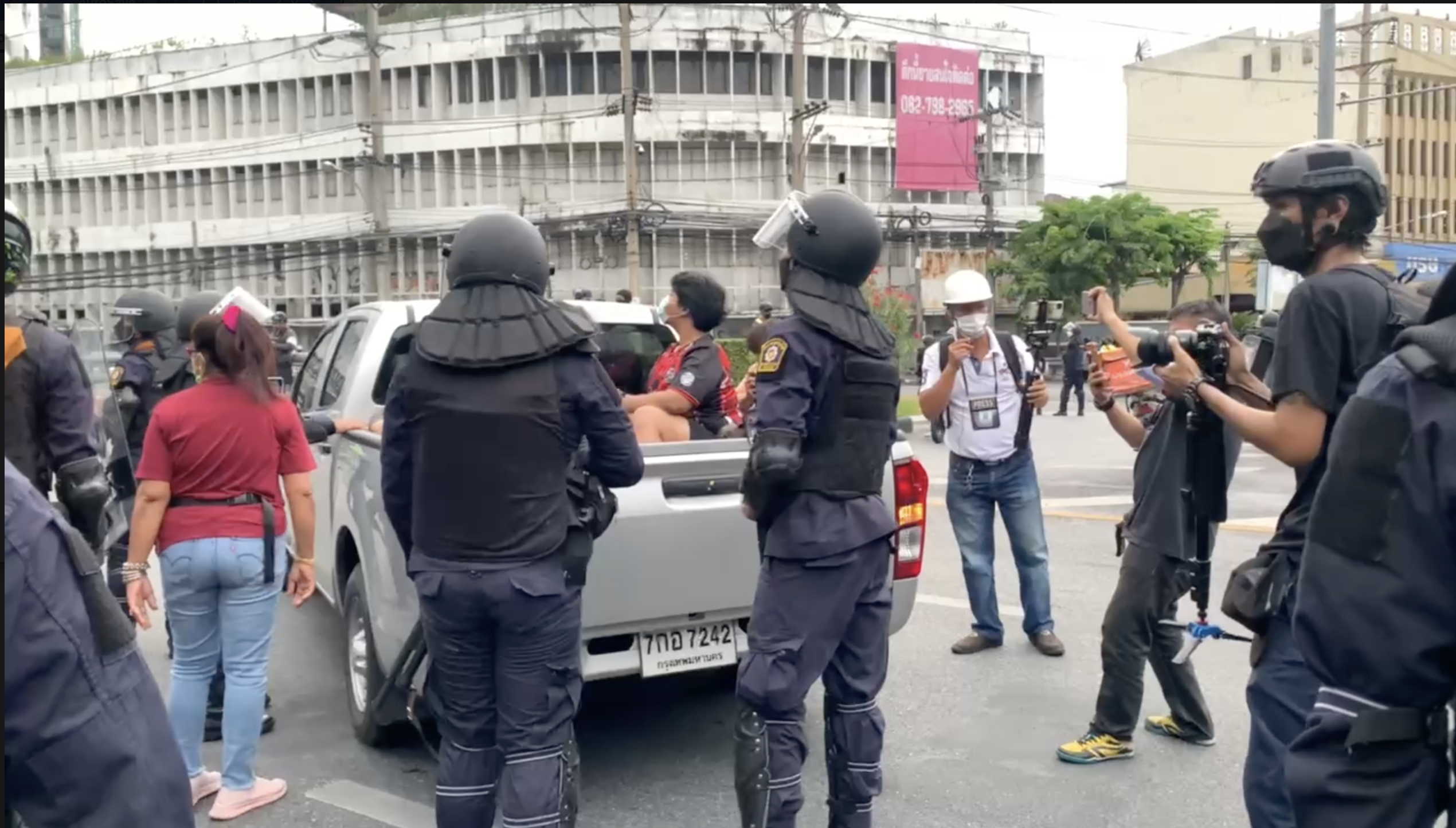
On 7 September 2021, the rapid mobile crowd control police with unmarked two pickup trucks with the crowd control police and rubber bullet guns on the back just rammed into the crowd of protesters at the Din Daeng Intersection. Photo by Mob Data Thailand
In addition, in another incidence, a prisoner transport vehicle rammed into the protesters on 12 September 2021 at the Din Daeng Intersection during the curfew time. The Reporters livestreamed when the prisoner transport vehicle drove in high speed toward the public assembly at the Din Daeng Intersection and rammed into one protester sending him flying more than two meters away. It caused him to sustain an injury on his chin and the requirement of collar. He was then brought to the Rajavithi Hospital. On 13 September 2021, the police in a press conference insisted that the driver was a Metropolitan Police official and explained that the official had to drive away from the area since the protesters were starting to pound his vehicle. And after he hit a protester, he looked back and saw the person was not seriously injured, so he drove and pulled the car over at the Phramongkutklao Hospital.

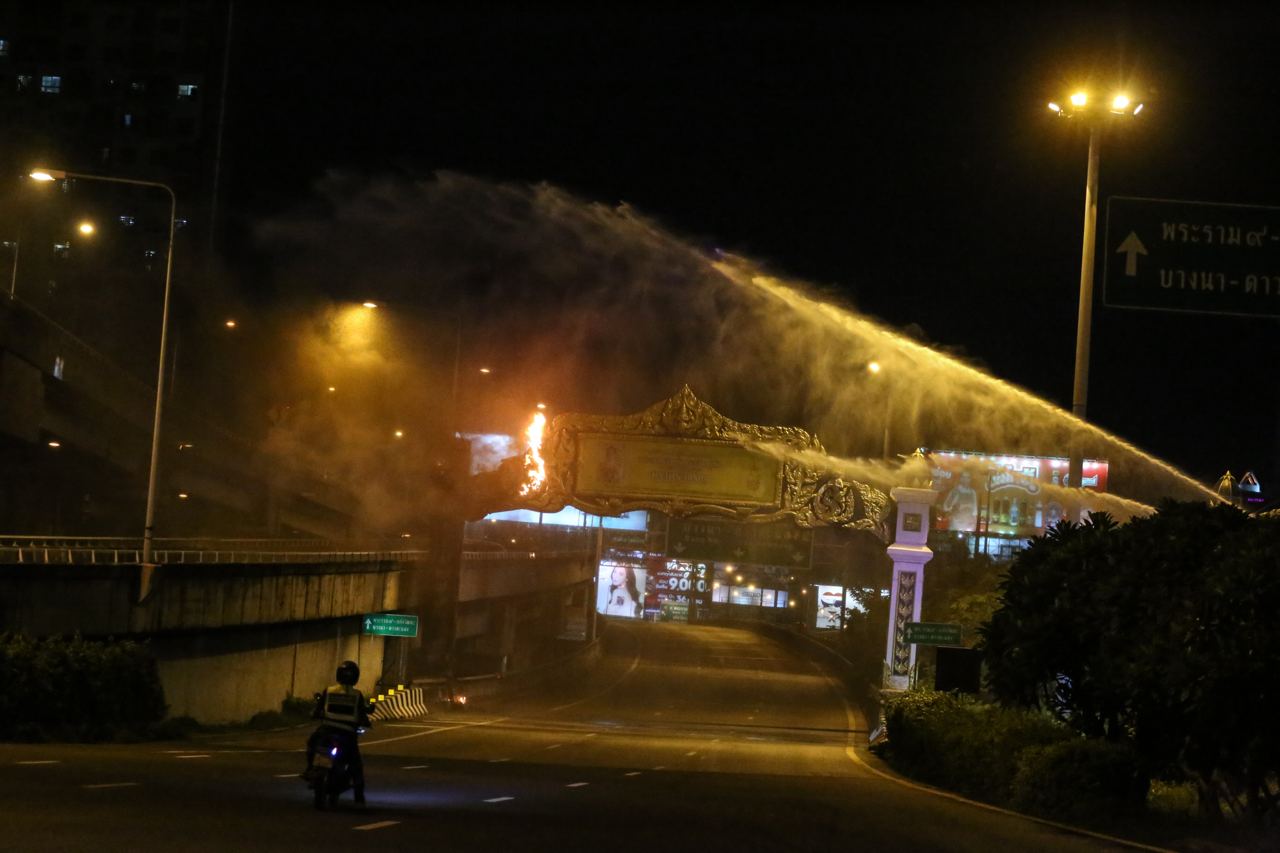
The dispersal of the public assembly on 12 September 2021. Photo by Mob Data Thailand
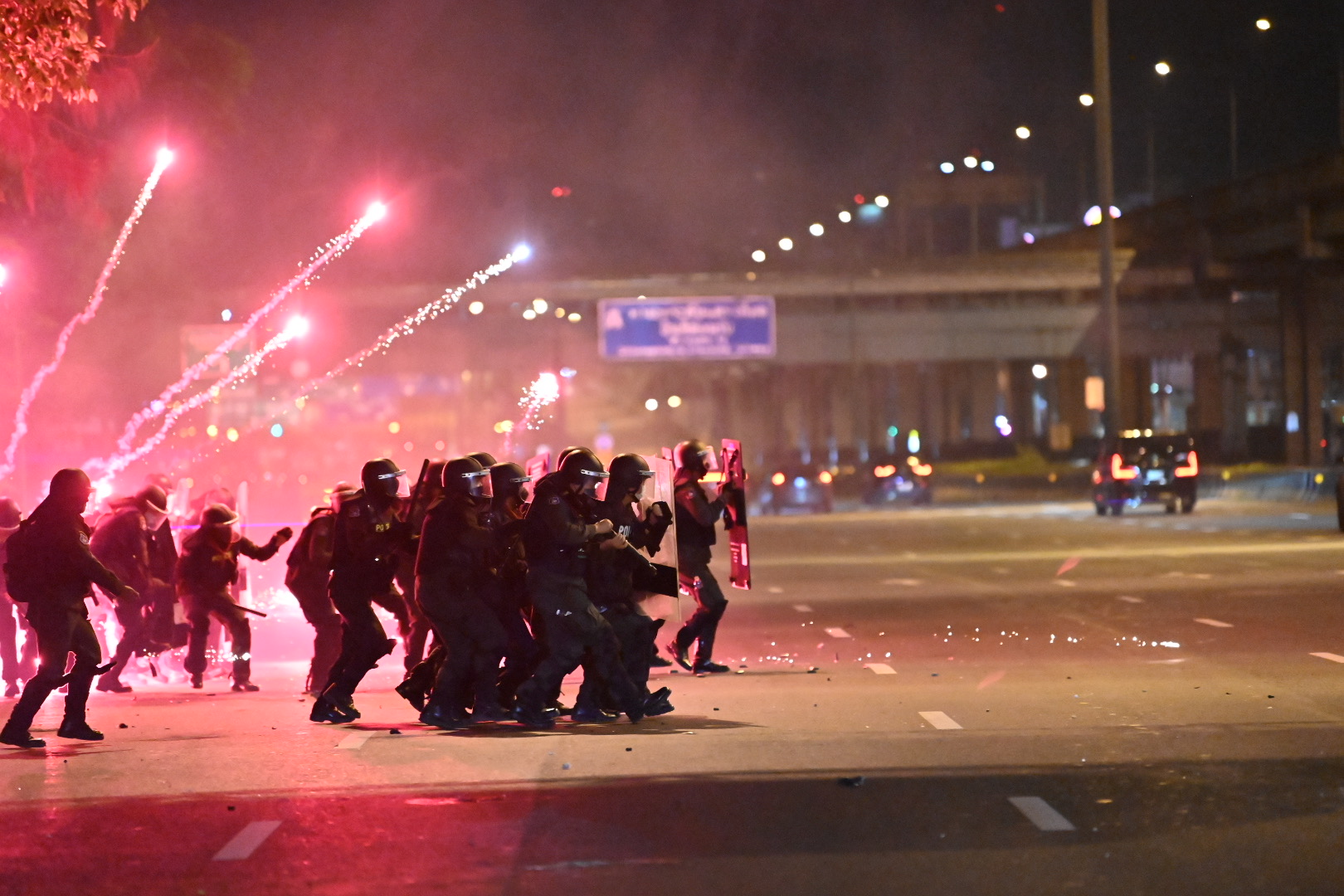
The dispersal of the public assembly on 13 September 2021. Photo by Khaosod English
On 11 September 2021, the police conducted a containment in the area in front of the Din Daeng District Office on Mitra Maitree Rd. toward the Din Daeng Intersection. Prior to this, there was a clash between the police and the independent protesters and tear gas and rubber bullets were fired in retaliation. As the curfew kicked in, the police conducted a containment of the area and told the journalists to stop livestreaming and asked to examine press passes. On the same day, the Thai Lawyers for Human Rights (TLHR) reported that arrests were made against the protesters, medics, and first responders as well as non-protesters, over 78 of them. It was the largest crackdown in September. Meanwhile, five police officials got injured with one suffering from a serious injury as a result of be thrown at with giant firecracker on his face and right eye. On 13 September 2021, curfew time, in Soi Mitr Maitree 2m the rapid mobile officials arrested the remaining protesters leading to the arrests of two independent media and one medic volunteer, altogether 11 who were charged. In addition, on 19 September 2021, the officials have adapted the tactic to prevent the gathering of the Thalugaz by taking control of the area in the Din Daeng Intersection with forces from the crowd control police and the Metropolitan Police.
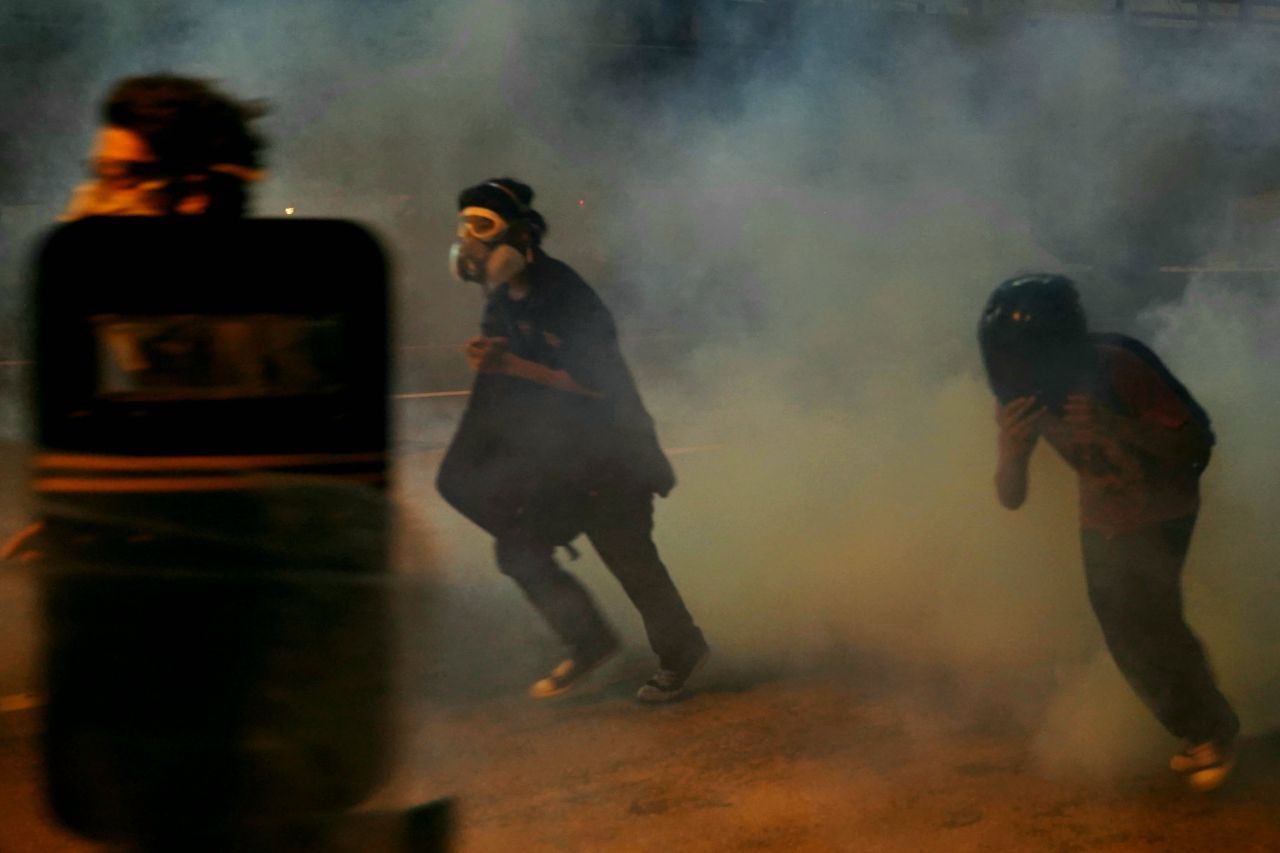
On 11 September 2021, there was a clash between the police and the independent protesters and tear gas and rubber bullets were fired in retaliation. Photo by Prachatai
Protest dispersal
Has there been restriction of public assemblies? If so, what kinds of methods/equipment have been used?
Even though the state may restrict the right to peaceful public assembly in some cases, but the authorities must be able to show that any restrictions meet the requirement of legality, and are also both necessary for and proportionate to at least one of the permissible grounds for restrictions enumerated in article 21. The prohibition of a specific assembly can be considered only as a measure of last resort. Where the imposition of restrictions on an assembly is deemed necessary, the authorities should first seek to apply the least intrusive measures. States should also consider allowing an assembly to take place and deciding afterwards whether measures should be taken regarding possible transgressions during the event, rather than imposing prior restraints in an attempt to eliminate all risks.
According to the Royal Thai Police, throughout the public assenblies from 2020 until now, the authorities often install ship containers or barbed wire claiming to prevent any disturbance caused by the public assembly and for security of important places. The public assemblies, in particular by the Redem, have often ended with the dispersal showing how the authorities already presume any public assembly is an exercise of right unpeacefully and it has to be stymied and stopped.
On 4 September 2021, the Redem called for a gathering at the Switzerland Embassy on Wireless Rd. from where they would walk toward the lawn in front of the King Rama VI Monument at the Lumphini Park. The police by the spokesperson of the Metropolitan Police then told the press that from now on, it shall be focused on ensuring security of venues.
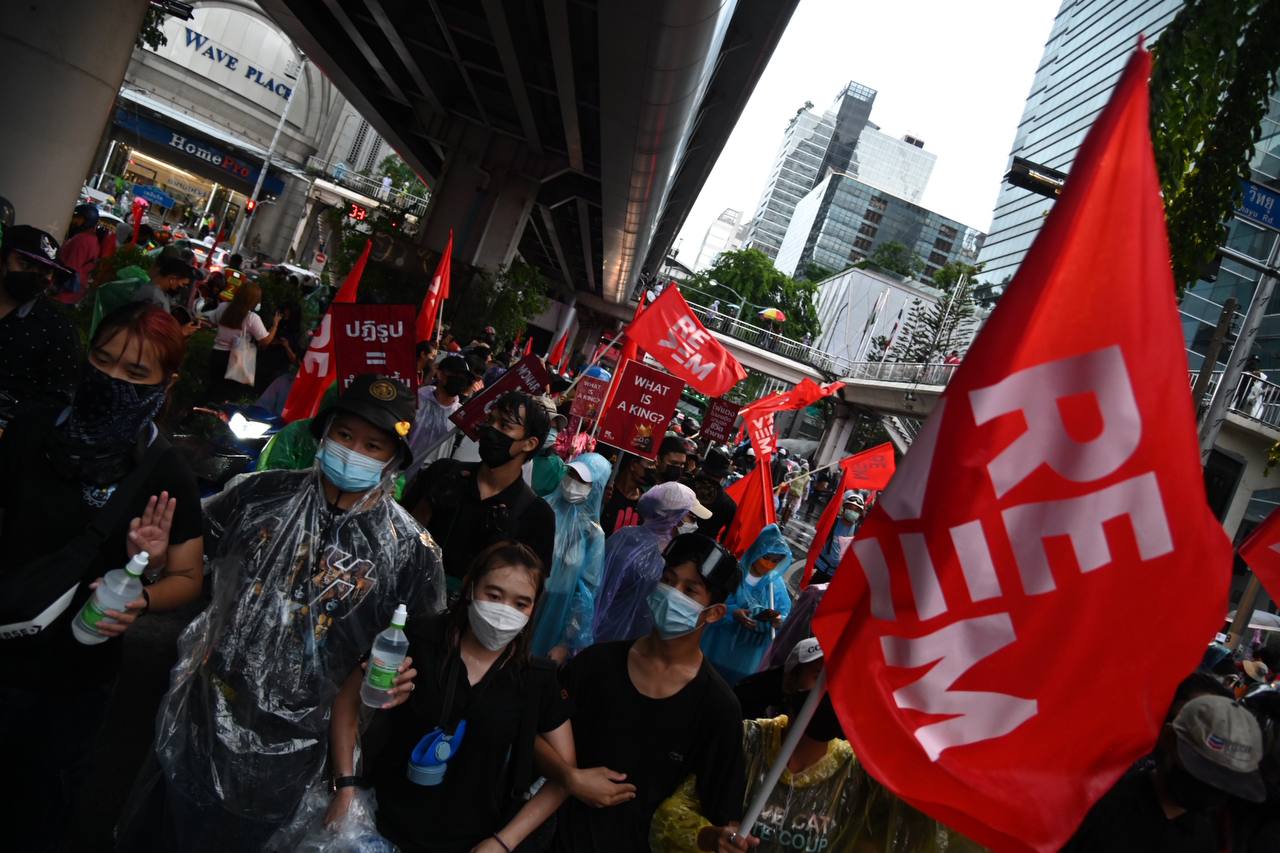
On 4 September 2021, the Redem called for a gathering at the Switzerland Embassy on Wireless Rd. Photo by Mob Data Thailand
The route toward the Lumphini Park was blocked by ship containers including around the Grand Hyatt Erawan Bangkok. The authorities blocked both the inbound and outbound of Ratchadamri Rd. and the Ratchaprasong intersection, the Wireless Intersection toward the Lumphini Park. Lines of one layer of containers were made with metal panels and barbed wire. The police forces were deployed behind the containers. Around Lang Suan which is another route toward Ratchadamri Rd., the roads there were blocked with barbed wire and black nets. The police further expanded the blockade to the Rama I Rd preventing the through traffic from Chalerm Phao Intersection to Ratchaprasong intersection. The venue was basically completely cordoned off. In front of the Monument of King Rama VI, the police simply put there iron barriers with the deployment of one row of crowd control police.
In addition, when the participants started to walk and pass the Police General Hospital at the Ratchaprasong intersection, the officials put up another barbed wire deployed there water cannon trucks, and crowd control police.
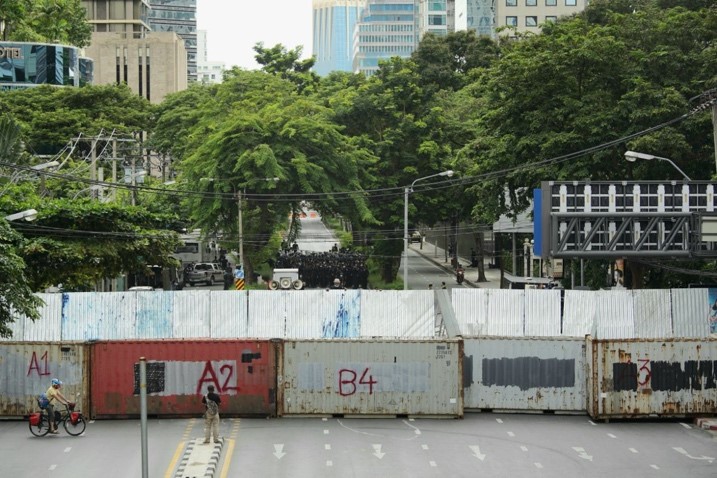

Ship containers placed on 4 September 2021 in response to public assembly of Redem at Wireless Intersection (Pics 1 - 2)

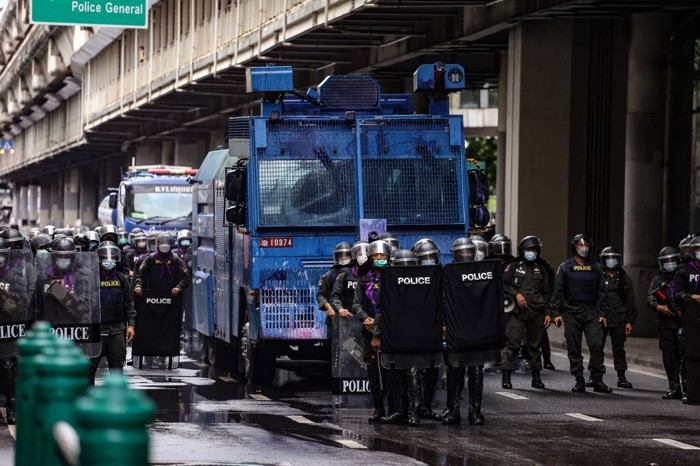
The barbed wire and barriers with water cannon truck and crowd control police fully armed with crowd control gears on 4 September 2021 to respond to the public assembly of Redem at the Police General Hospital, Ratchaprasong intersection (Pics 3 - 4)

Officials on 4 September 2021 to respond to the public assembly by Redem at the lawn of the King Rama VI Monument, Lumphini Park (Pic 5)
Pics 1 – 5, objects installed on 4 September 2021 to respond to the public assembly by Redem at the Wireless Intersection toward Lumphini Park
Apart from installing barriers and blocking traffic routes, checkpoints were set up on Sathon Rd. toward the Wireless Intersection opposite to Bangkok City Tower. The police set up checkpoints and randomly searched motorcycles including backs, under the saddles, and in the boxes on food delivery drivers.
During the public assembly on 19 September 2021, the officials have adapted the tactics again in Din Daeng by taking control of the Din Daeng Intersection and setting up various checkpoints. The deployment of crowd control police and border patrol police in the outbound of Vibhavadi Rangsit Rd. started from around 16.00, before the usual time the Thalugaz would converge. The crowd control police, the border patrol police and the traffic police were deployed under the Din Daeng Expressway with the police vehicles parked in a long line along the outbound of Vibhavadi Rangsit Rd. from the Din Daeng Intersection toward the Royal Thai Army Band Department. The police also set up checkpoints on any road leading to the Din Daeng Intersection including from the Pracha Songkhrao Intersection and Rajavithi Rd. Nevertheless, the independent protesters have shifted to converge at the Nang Lerng Intersection while the officials set up a barrier with barbed wire at the Kromluang Chumporn Khet Udomsak Shrine and placed ship containers across the Chamai Maruchate Bridge. As the independent protesters started hurling objects at the barriers, the officials fired back with tear gas to stop the approaching protesters. THLR later reported that 22 were arrested on 19 September 2021 and 11 were injured by the arresting officials including three minors who were shot with rubber bullets. Two of them have to be taken to hospital for sustaining head wound and shoulder wound during the arrest. Most of the arrests took place after the disbanding of the public assembly.
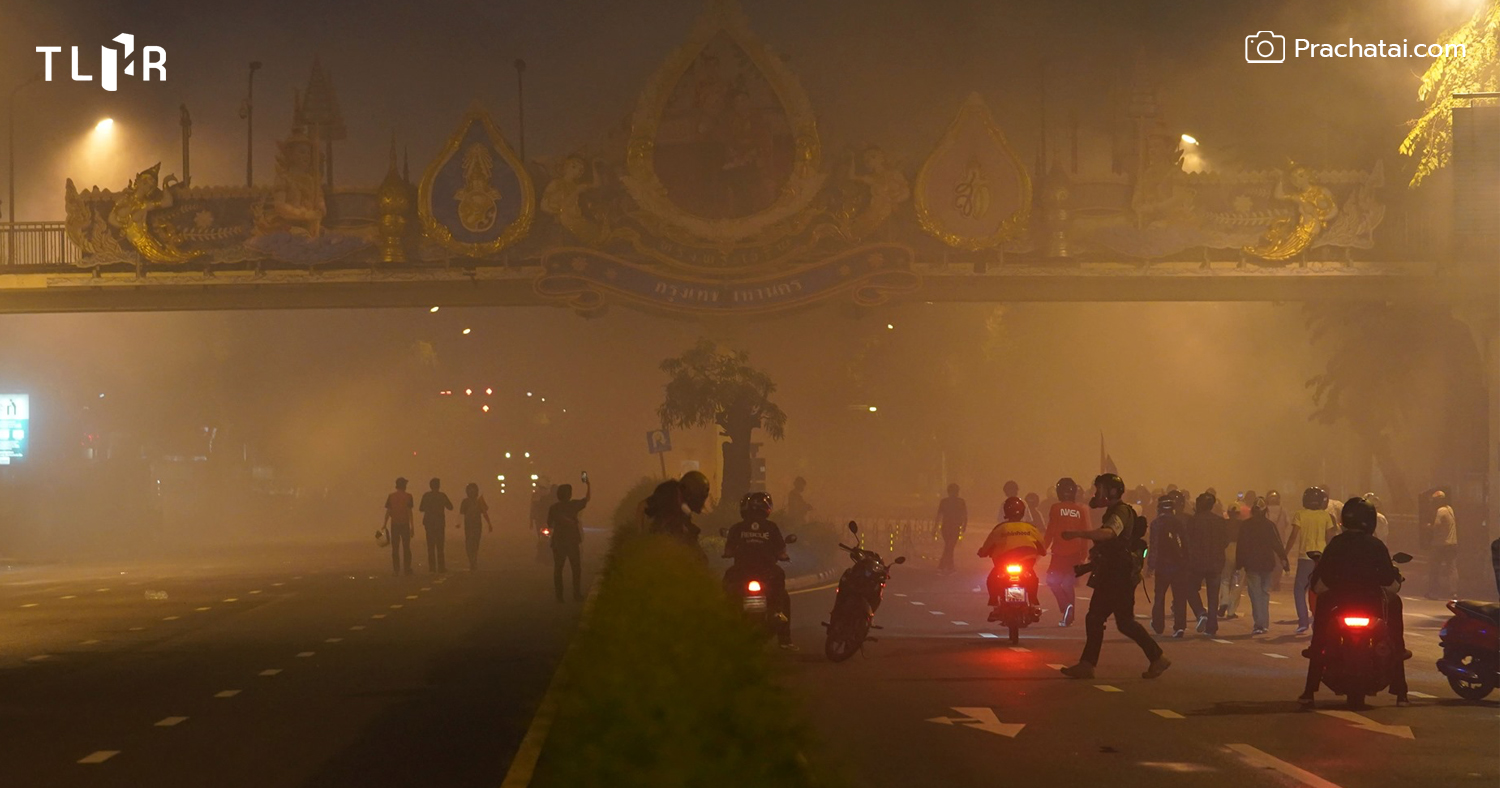
During the public assembly on 19 September 2021, the officials have adapted the tactics again in Din Daeng by taking control of the Din Daeng Intersection. Photo by Thai Lawyers for Human Rights
Another group that has been subject to forcible dispersal every day toward the end of September 2021 was the Thalufah which has resumed its actions after its attempt to walk toward the Government House during 25-29 September 2021 under the campaign “Stop the Prayut Dynasty”. A series of activities were launched to demand the removal of General Prayut Chan-ocha as Prime Minister.
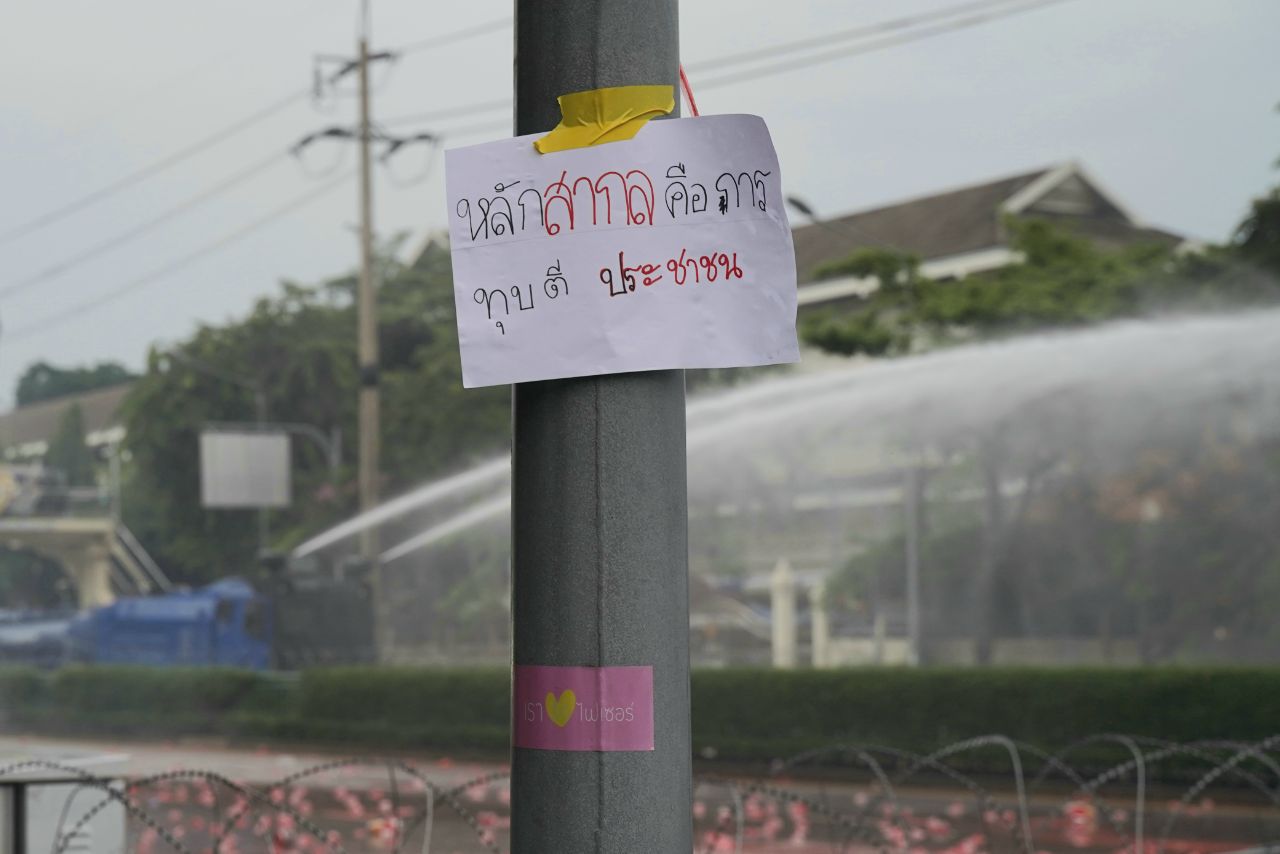
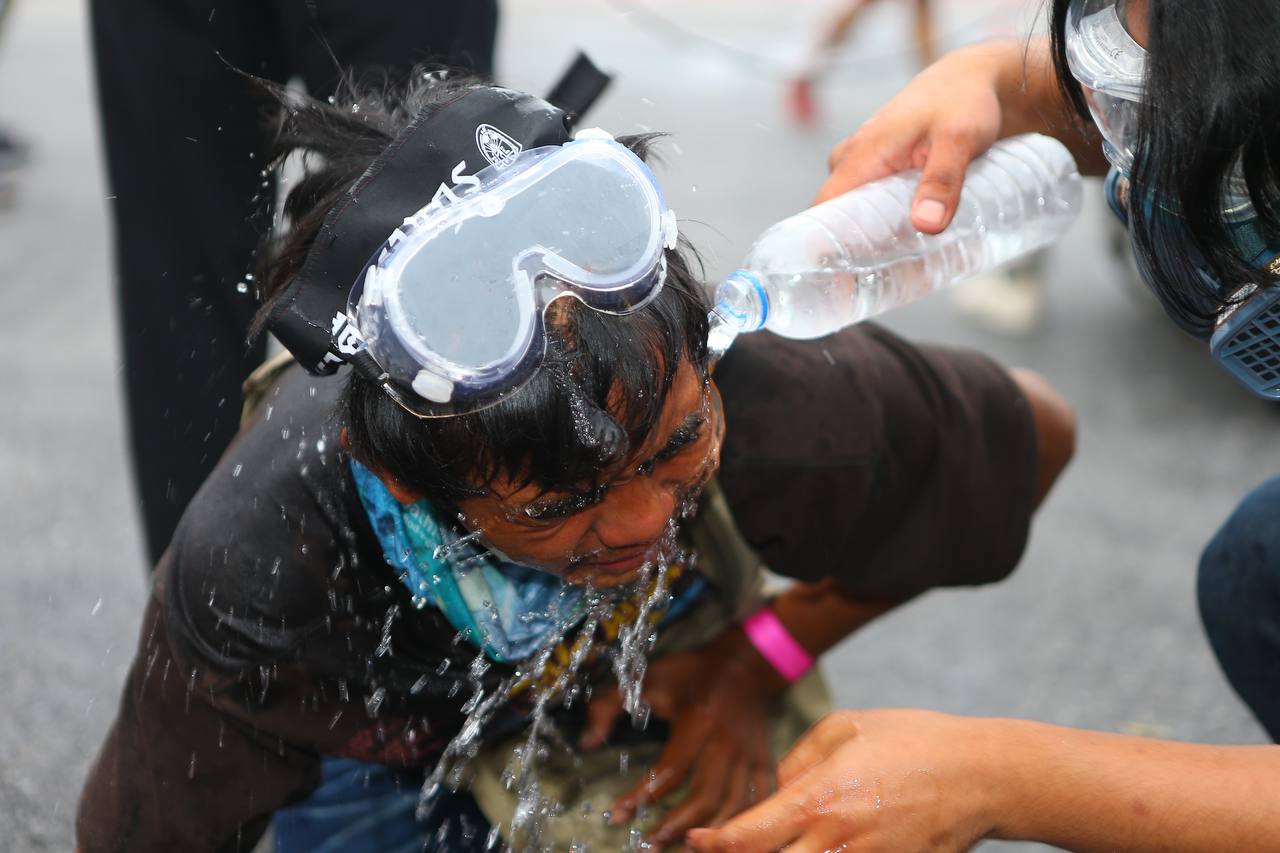
The dispersal of the public assembly on 25 September 2021. Photo by Mob Data Thailand
Nevertheless, the officials placed barriers from Nang Lerng Intersection, both inbound and outbound, toward the Government House with barbed wide and iron barriers. 15 meters away was another lawyer of barrier. Water cannon trucks were deployed. Around the Government House, barbed wire was installed covered with nets. During the five straight days, the Thalufah tried to move toward the Government House, but they were dispersed with crowd control equipment including water cannon laced with color to identify the targets and water laced with irritant chemical. Meanwhile, the officials conducted a containment and carried out arrests of the participants using their rapid mobile units. As a result, at least 50 were arrested. From the public assembly on 25 September 2021, 15 were arrested including nine minors, 27 October 2021, 26 were arrested with four minors, 28 September 2021, nine were arrested including two minors, and 29 September 2021, no arrest was made, but the officials dispersed the public assembly with water cannon and tear gas.
The deployment of forces and the duration announced for the public assembly to disband itself
Even though it is not clearly prescribed in international human rights standards about the duration within which the authorities have to allow the participants to disband themselves or prior to the dispersal of public assembly, but according to General Comment no. 37, the less lethal weapons (tear gas, water cannon which includes the water cannon truck, firearm which includes firearms for shooting rubber bullets) ‘should be used only as a measure of last resort, following a verbal warning, and with adequate opportunity given for assembly participants to disperse.’ In principle, it is incumbent on the officials to conduct the dispersal of a public assembly or use force to disband a public assembly in compliance with the fundamental principles of legality, necessity, proportionality, precaution, and non-discrimination. It means the authorities are prohibited from dispersing the public assembly arbitrarily. Therefore, Article 21 of the Public Assembly Act 2015 provides that the police or policing officials may use their discretion to disperse a public assembly, although subject to judicial review, such dispersal can be stopped.
Moreover, even though General Comment no. 37 prescribes for the rights during the state of emergency that the right to peaceful public assembly is a derogable right. Nevertheless, it is incumbent on the state to demonstrate that a public assembly or a public gathering poses a threat to the survival of the nation and it must comply with the requirements provided in Article 4 of the International Covenant on Civil and Political Rights which clearly states that in time of public emergency, the States Parties may take measures derogating from their obligations under the present Covenant to the extent strictly required by the exigencies of the situation, provided that such measures are not inconsistent with their other obligations under international law and do not involve discrimination solely on the ground of race, colour, sex, language, religion or social origin.
After more than one year and six months for the enforcement of the Emergency Decree on Public Administration in the State of Emergency 2005, the Public Assembly Act has been suspended, so have various regulations applying to the officers policing public assembly. But in reality, the authorities continue to claim such public gatherings or public assembles are unlawful. They even claim the gatherings contravene the Emergency Decree on Public Administration in the State of Emergency 2005 and proceed to disperse the public assembly using water cannon laced with tear gas, firing rubber bullets and tear gas to immediately disband the assembly, or to kettle and arrest them. This has happened particularly in the Samliam Din Daeng Intersection where the Thalugaz youth converge. Water cannons are fired directly at them, as the officials kettled paving the way for the rapid mobile units to arrest the protesters.
During their actions, even though the organizers of public assembly or the participants have failed to act according to some requirements of domestic law regarding public assembly including the Emergency Decree on Public Administration in the State of Emergency, but this may not deprive the participants of the protection according to Article 21 of the ICCPR. The possibility that a peaceful assembly may provoke adverse or even violent reactions from some members of the public is not sufficient grounds to prohibit or restrict the assembly.
During the past September, the officials often resorted to use rapid mobile units for kettling the area and carry out mass arrests. Checkpoints were set up to conduct the search. From the first dispersal of public assembly on 16 October 2021 until the dispersal of public assembly in August 2021, the duration given to the participants to disperse themselves and before the containment was too short. There were merely some warnings that the assembly was ‘illegal’ or ‘violated the Emergency Decree on Public Administration in the State of Emergency’ before starting to disperse the public assembly by firing water cannon laced with tear gas at the participants, firing rubber bullets in close range, and arresting the injured persons or the persons who were unable to escape from the use of the equipment in time.
General Comment no. 37 clearly states that containment or kettling may be used only where it is necessary and proportionate to do so, in order to address actual violence or an imminent threat emanating from that section. Particular care must be taken to contain, as far as possible. Where containment is used indiscriminately or punitively, it violates the right of peaceful assembly, and may also violate other rights such as freedom from arbitrary detention and freedom of movement. But the mass arrests of the participants shows how it clearly failed to meet the requirements of necessity and proportionality.
In addition, General Comment no. 37 also clearly prescribes that crowd control police who police the public assembly must have received training on public assembly policing and relevant human rights standards already. This stands contrary to the reality in various instances since the public assemblies in August when containment and mass arrests have begun. On 6 September 2021, in front of the Royal Thai Army Band Department on the outbound Vibhavadi Rangsit Rd., the crowd control police have kettled and made the arrests while vehicles continued to pass by. The Ratsadon News livestreamed when the crowd control police surrounded a passing motorcycle and hit the driver with a truncheon to hold the person in custody. The officials continued hitting the person even though he did not appear to show any resistance.
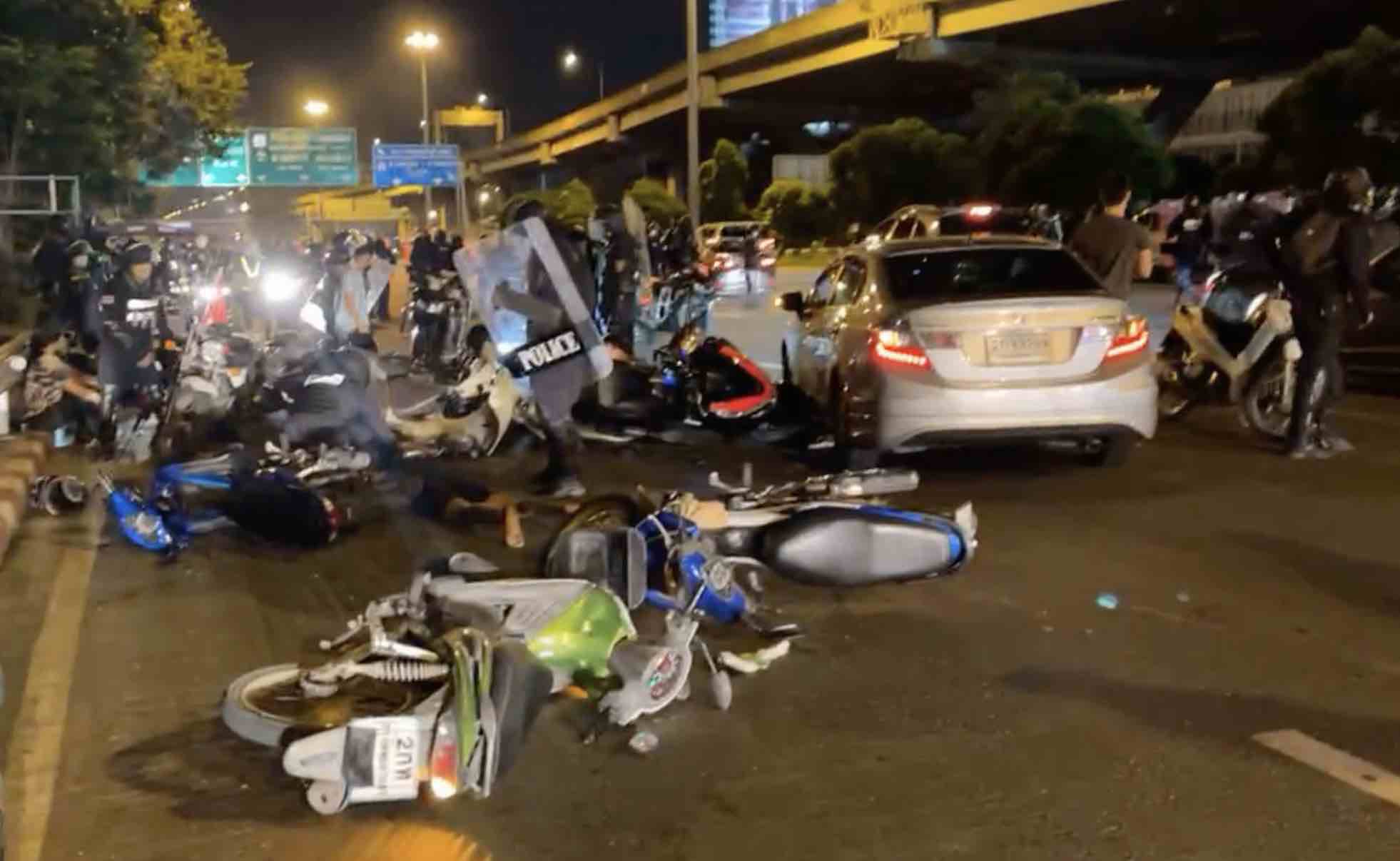
On 6 September 2021, in front of the Royal Thai Army Band Department on the outbound Vibhavadi Rangsit Rd., the crowd control police have kettled and made the arrests while vehicles continued to pass by. Photo by @Youththroughgas
In addition, a video clip shows how the officials fired tear gas horizontally. But according to the UN Guidance on Less-Lethal Weapons in Law Enforcement issued by the Office of the United Nations High Commissioner for Human Rights, the firing of rubber bullets must be aimed at the lower part of the body and the tear gas canisters from distance must be fired in a semicircle projectile.
On 17 August 2021, Pol Lt Gen Pakapong Pongpetra, Commissioner of the Metropolitan Police Bureau, also joined the demonstration of the firing of tear gas to the Thai media. The tear gas canisters were fired in semicircle projectile at more than 30 degrees. He insisted that the firing of tear gas was not harmful and refuted news that spread online earlier that one protester suffered a serious injury on his face after being fired at with tear gas canisters. He insisted that the officials were ready to act in compliance with international standards.
In addition, the use of truncheon by the crowd control police should just serve the self-defense purpose, not to attack another person. But clearly from the livestream, the officials hit the truncheon at the body of the individual who was riding a motorcycle past them even though the person did not show any resistance.
There was less use of water cannon and tear gas to disperse the public assembly in September as the authorities have adapted their operational plans to use rapid mobile units to arrest the protesters instead. New gun was also used by the crowd control police to fire spherical projectiles when conducting the containment of the area around the Din Daeng Flat and Soi Mitr Maitree.
As the impact on the local community in Din Daeng grew, local residents in the area have complained with concerned authorities. For example, on 24 August 2021, Mr. Prasong Homsanan, a community committee member of Din Daeng Flats no. 1-17 has submitted a letter of petition as the residents in Din Daeng Flats have suffered from the public assemblies and the clashes between the police and the participants. The letter was addressed to General Prayut Chan-ocha and sent via the Government Complaint Center and the Royal Thai Police. They demanded the change of operation by the crowd control police and urged responsible persons to examine the damage in the past one month since the residents have suffered from the impacts of the public assemblies and the response of the crowd control police and their superior officers.
Nevertheless, in September, the authorities have adapted their operational plans as mentioned earlier. They have started to arrest the participants in the residential area and continued to fire rubber bullets and tear gas into the area. For example, at the public assembly on 11 September 2021, according to the residents, the dispersal of the public assembly took place without warning and tear gas was fired continuously. The owner of a motorcycle repair shop explained how his house has been affected by the tear gas which has been fired through the roof of his shop. In addition, local residents found spherical projectiles, larger than the beads used by the participants. On 17 September 2021, VoiceTV reported about the FN303 anti-riot gun filled with spherical projectiles used by the crowd control police. And on 23 September 2021, VoiceTV reported again that spherical projectiles were fired from the officials and they were used during the containment on the Mitra Maitree Rd. where independent participants or the Thalugaz converged. Such glass beads are not included in the Notification of the Prime Minister Office of the list of crowd control devices.
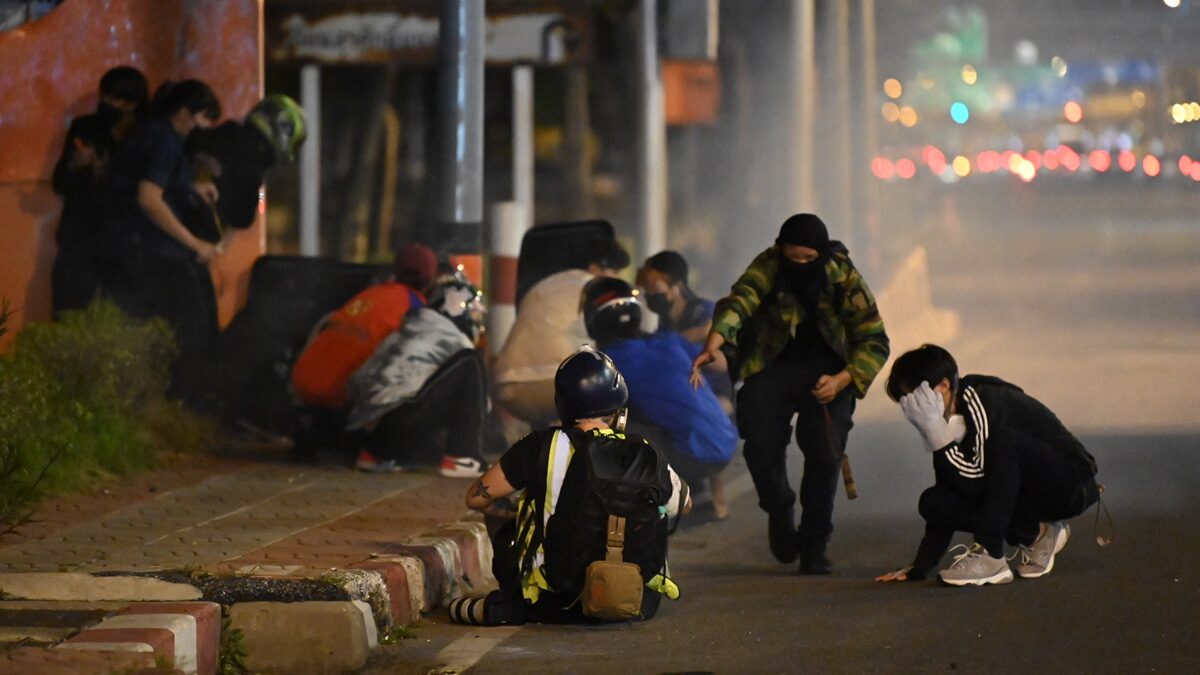
The dispersal of the public assembly on 11 September 2021. Photo by Khaosod Online
Meanwhile, since August 2021, the persons held in custody often suffered an injury during the arrests. For example, on 19 September 2021 during the widespread public assemblies at Nang Lerng Intersection and the Victory Monument by the independent groups or Thalugaz, according to TLHR, the crowd control police arrested the protesters and some sustained physical injuries during the arrest. This included youth including a 15-year-old-child and a 16-year-old-child. After the arrest, a 15-year-old-child suffered head wound and had to be brought to the Police General Hospital and only met the lawyer later. The child’s body sustained bullet wounds and the person’s left face and above the ankle were hit causing gaping wounds that need stitches. The 16-year-old-child who was held in custody at the Phahonyothin Police Station, according to his lawyer, sustained a large wound on his right shoulder with some bleeding and some small cuts on his right waist. The youth was beaten up and sustained a rubber bullet wound on his right fingers and above left elbow. The lawyer has thus asked the police to bring him for treatment at the Police General Hospital.
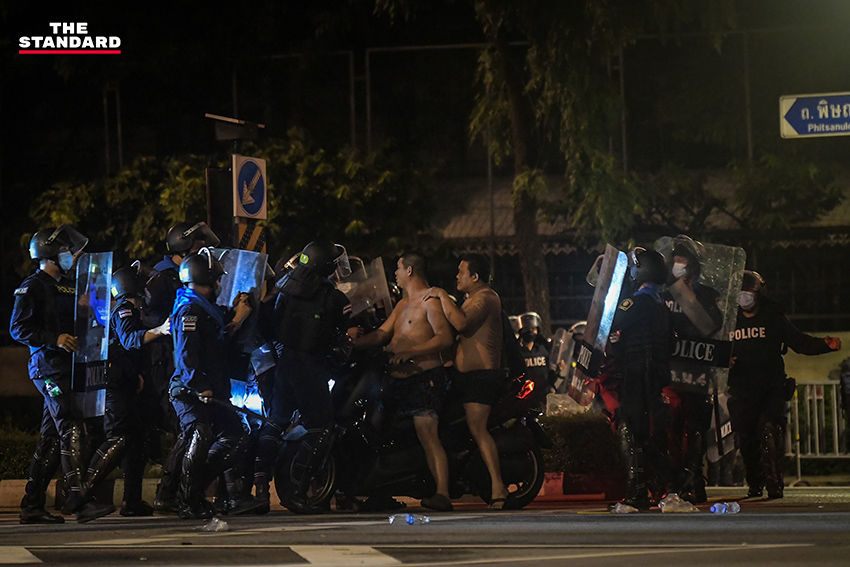
A clash between the police and the independent protesters, 19 September 2021. Photo by The Standard
As to the requirements to disperse the public assembly, as mentioned earlier, since the Public Assembly Act has been suspended, the requirements invoked by the police to disperse the public assembly become unclear. Lately, they rarely refer to ‘violence’ caused by the participants and simply claim such public gathering and public assembly is a breach of the Emergency Decree on Public Administration in the State of Emergency and proceed immediately to disperse the public assembly without giving the participants the opportunity to dissolve it by themselves or using other more proportionate measures.
Domestic laws fail to provide clear conditions to disperse the public assembly. The police simply disperse the public assembly by claiming that they have violated the Emergency Decree. The claim by the authority shall not deprive the participants from the protection under Article 21 of the ICCPR. In addition, the use of water cannon, rubber bullets and tear gas, even though they are less lethal equipment, but they can cause widespread impacts. In addition, it has been reiterated that rubber bullets should not be used to police a public assembly. But they have been used as a first priority, not the las resort after giving verbal warning and ‘adequate opportunity given for assembly participants to disperse’. The firing of rubber bullets ‘must be limited to targeted individuals in circumstances in which it is strictly necessary to confront an imminent threat of death or serious injury’ It is never lawful to fire indiscriminately or to use firearms in fully automatic mode when policing an assembly.
As the use of force to carry out an arrest, General Comment no. 37 clearly states that the law enforcement officials must not use excessive force and disproportionate to the situation to lawfully disperse the public assembly to make an arrest or to aid the arrest of a perpetrator or a suspect. Domestic law must not bestow on the authorities so excessive power, i.e., the mandate to use power without the requirement of necessity or without adequate safeguard when conducting the arrest including by hitting truncheon at the person held in custody or firing rubber bullet in their back. Testimonies from persons held in custody unanimously attest to how the crowd control police have forcible arrested the protesters and non-protesters without heeding to the requirements of necessity and proportionality causing a massive number of injuries. Some non-protesters were children and youth. For example, on 11 September 2021, 18 persons who were arrested were non-protesters. They were people who waited to receive donated foot, motorcycle taxi drivers, taxi drivers, dessert settlers, food sellers present at the demonstration sites. One of them was an attorney who was on the way home from work. The arresting officials have failed to act according to the due process of law and failed to identify themselves as competent officials or officials who have power to carry out a lawful arrest.
In addition, in September, some independent protesters or the Thalugaz continued to use some equipment including big firecrackers, tennis ball bombs, firework, molotov cocktail, glass beads and slingshot to retaliate the officials. Meanwhile, the officials use new weapons such as the FN 303 gun loaded with spherical projectiles which can cause fatal wounds. Nevertheless, the officials have executed the warrants to arrest individuals in the aftermath of the public assembly including those accused of destroying public property including destroying cctv camera, setting fire on traffic boxes, spraying paint and setting fire on the portrait of King Rama X, etc. In the latter incidence, the individuals were pressed with lese majeste charge, the violation of the Penal Code’s Section 112 including some youth.
The setting of fire on the portrait of King Rama X took place at least in three places including on 12 September 2021 at the Din Daeng Intersection, the Royal Arch at an exit of the Din Daeng Expressway during the public assembly of the independent group or the Thalugaz. The officials use water cannon to put out the fire just in time. On 13 September 2021, the royal portrait in front of the Srinagarindra Hospital, Khon Kaen University, was set ablaze including on 14 September 2021, the Royal Arch in front of the Ministry of Labour in Din Daeng where the Thalugaz protesters were converged. The police have been able to carry out the arrest and prosecution quickly. Nut (not his real name), a 14-year-old-boy was arrested at his home by plainclothes officials who have raided and searched his home without any warrants. He was later pressed with six charges including mainly the lese majeste, an offence against the Penal Code’s Section 112, setting fire on property according to the Penal Code’s Section 217, and offence against the Regulation to ban a public gathering a manner that risks spreading the disease and the curfew ban according to the Emergency Decree on Public Administration in the State of Emergency 2005 and the Communicable Diseases Act 2015. At present, Nut is still remanded in custody in prison since his parents did not come forward to bail him. In two other cases on 13 and 14 September 2021, the officials charged the suspects for setting fire on property, but not on Section 112 at the Muang Khon Kaen Police Station, and on setting fire on property and lese majeste or Section 112 at the Din Daeng Police Station, respectively.
Response of the officials toward media and observers during the assemblies
Policies-statements of the Royal Thai Police and the Metropolitan Police Bureau (if any) toward the performance of duties of media
Media and observers in public assembly enjoy protection and their roles are recognized as extremely important for the exercise of the right to peaceful public assembly. Media and observers in public assembly thus afford protection from the state parties to the ICCPR, and according to the interpretation of the UN Human Rights Committee’s General Comment no. 37. It means that media and observers in public assembly which monitor the performance of law enforcement officials must not face reprisals or other harassment, and their equipment must not be confiscated or damaged. Even if an assembly is declared unlawful or is dispersed, that does not terminate the right to monitor.
Nevertheless, throughout September, media and observers have been subject to restriction, i.e., journalists were confined to just the footpath, the examination of journalist cards after curfew and the prosecution of citizen media in several public assemblies, particularly in Din Daeng. This echoes the attempt to isolate unaffiliated media to pave the way for the use of violence to suppress the protesters.
On 25 August, press organizations have met with the Metropolitan Police Bureau over the emblem of press and it was agreed that a press armband would be made with reflective green color and the press emblem. Nevertheless, throughout September, even when journalists stood on the footpath as instructed, they were still targeted by blue laser and the rubber bullets were aimed at them. For example, on 13 September 2021, the mainstream media who worked in front of the Royal Thai Army Band Department reported that they were fired at with rubber bullets just to have them removed from the area.
Moreover, during the mass arrests, for example, on 11 September 2021, the journalists were told to stop livestreaming twice at Mitra Maitree and the Samliam Din Daeng Intersection invoking the curfew ban. They were told to vacate the area, otherwise, they would be held in custody. And on 13 September 2021, independent media were held in custody including the independent news centers and the admin of Free Our Friends facebook page. According to The Reporters’s interview of the Ratsadon News, the officials were looking for Ratsadon News. When he showed himself up and was asked about his press pass and license to work at curfew time, he said he was applying for them. As a result, the person was held in custody and charged for participating in the public assembly and violating the curfew ban. On 15 September 2021, during curfew time at the Mitra Maitree Intersection, the crowd control police conducted the containment of the area and the Katoey Mae Look On facebook page’s staff had a press pass and a permit to go outside during the curfew time from 21.00 – 04.00. Still, the staff member was charged for violating the Regulation issued under Section 9 of the Emergency Degree for assembling more than 25 individuals in the area designated by a Notification or an Order as a maximum and strict control zone and an offence against the Emergency Degree regarding curfew ban.
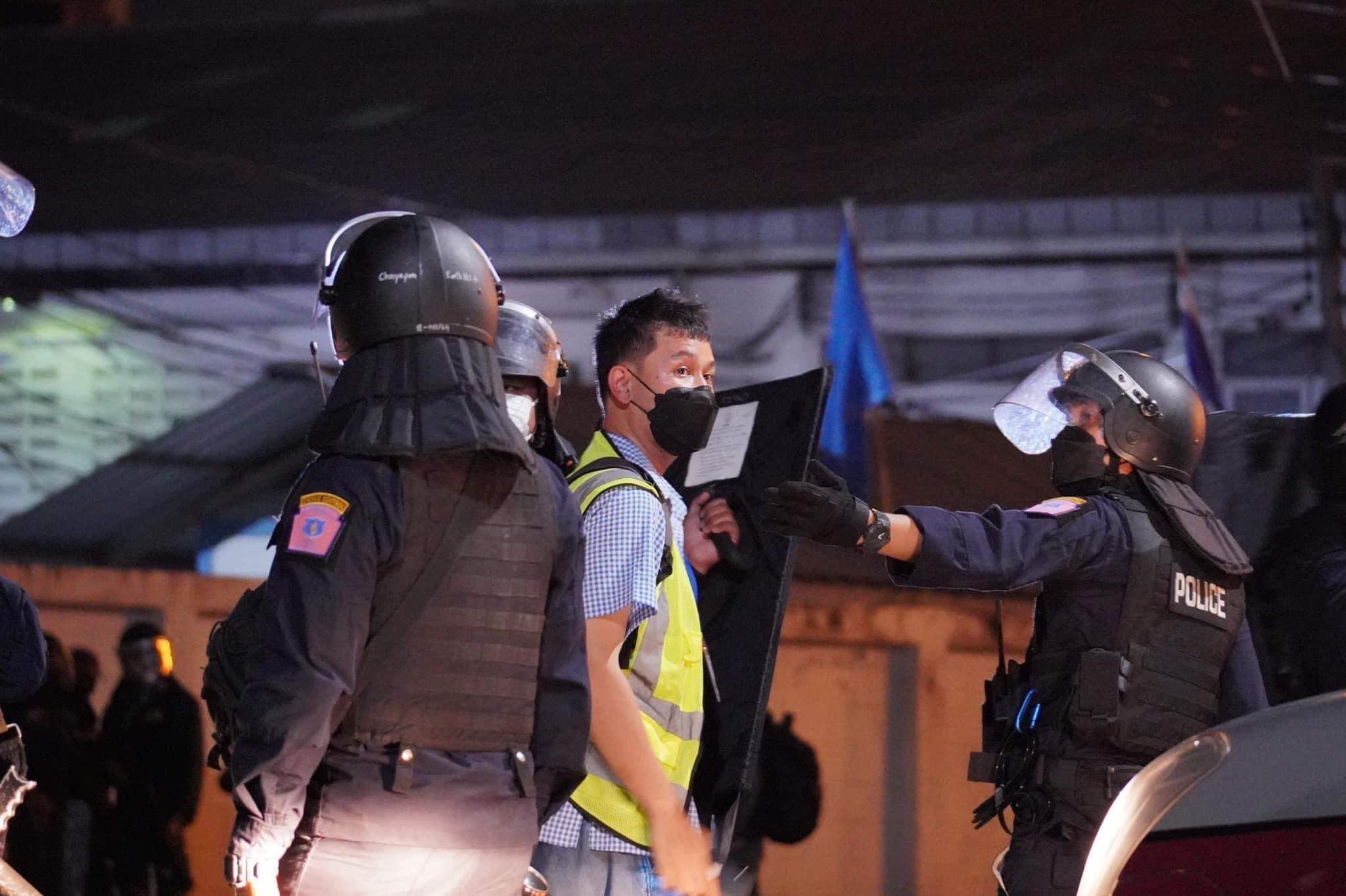
On 13 September 2021, independent media were held in custody. @KhaosodOnline
On 14 September 2021, the Deputy police spokesman Pol Colonel Krisana Pattanajaroen on the role of media to cover public assemblies has said that as to the freelance youtubers, the Media Federation is developing a regulation. Both domestic and foreign journalists have to adhere to the rule as other journalists. They have to identify their affiliation and no one has any privilege since there are the police, medical personnel, rescue personnel in the area. There are also journalists in the area to report news. If journalists cannot identify themselves, they shall be prosecuted. In order to observe a public assembly, one needs to send a letter of notification so that the authorities can get ready to offer protection and prevent any interference of a provocateur to cause disturbance.
